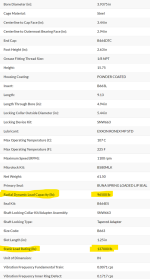1athoti
Mechanical
- Jun 1, 2022
- 14
Hi! I have a question regarding selecting bearings based on advertised load capacity.
I have a pulley with a resultant load of 142,000 lbs (A wire rope around the pulley with 100k tension. The wire rope does not wrap around 180deg but about 90deg, so vertical up and horizontal to the bull wheels). The pulley would have a very slow speed of maximum 10 RPM. As such, both static and dynamic loads are crucial.
I was intending to use 2 pillow block bearings - though I may have to use 2 flange bearings. I asked a reputable manufacturer if the bearings are designed to withstand this direction of load since initially I was not mounting the pillow block bearings directly in line with the resultant force of the wire rope. From their catalog I have this data on a 3-15/16 spherical roller bearing.
96.5k / 71k (per bearing) = 1.35SF is not great, but it is something...

However, the response I received from them, and I quote: "Can't even come close to handling the 72K with a 3-15/16 bearing. In fact even a 6-15/16 could not handle it. The "load rating" shown on the web site is a reference value only. In reality, only 25% of this value can be loaded to the bearing. This is a industry standard practice." (my bold and underline)
Is this truly so? I am no expert on bearings, do companies really advertise 400% more loading than they should??
Thank you for your input!
I have a pulley with a resultant load of 142,000 lbs (A wire rope around the pulley with 100k tension. The wire rope does not wrap around 180deg but about 90deg, so vertical up and horizontal to the bull wheels). The pulley would have a very slow speed of maximum 10 RPM. As such, both static and dynamic loads are crucial.
I was intending to use 2 pillow block bearings - though I may have to use 2 flange bearings. I asked a reputable manufacturer if the bearings are designed to withstand this direction of load since initially I was not mounting the pillow block bearings directly in line with the resultant force of the wire rope. From their catalog I have this data on a 3-15/16 spherical roller bearing.
96.5k / 71k (per bearing) = 1.35SF is not great, but it is something...

However, the response I received from them, and I quote: "Can't even come close to handling the 72K with a 3-15/16 bearing. In fact even a 6-15/16 could not handle it. The "load rating" shown on the web site is a reference value only. In reality, only 25% of this value can be loaded to the bearing. This is a industry standard practice." (my bold and underline)
Is this truly so? I am no expert on bearings, do companies really advertise 400% more loading than they should??
Thank you for your input!
